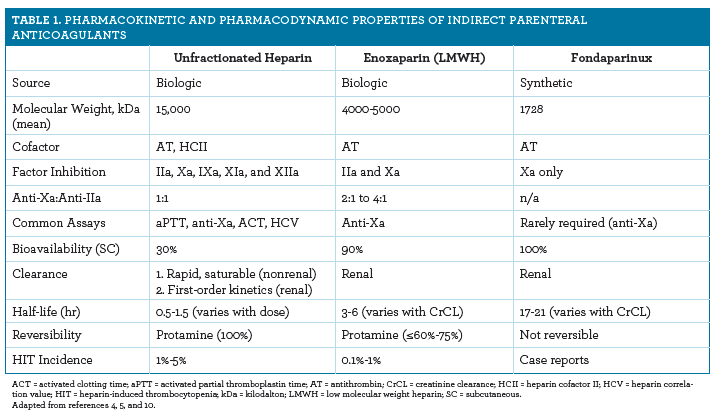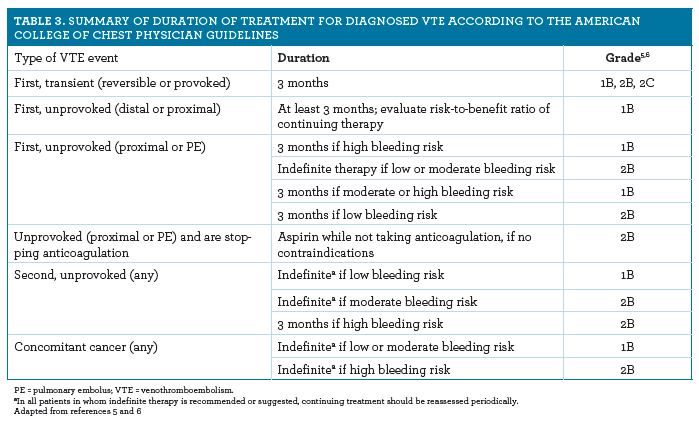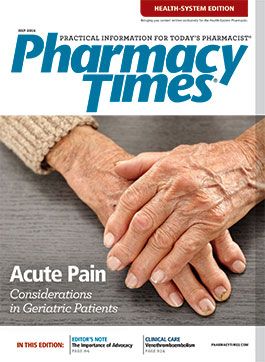Venothromboembolism: Treatment Recommendations and Therapeutic Options
Venothromboembolism has an annual incidence of 1 or 2 cases per 1000 individuals and is the third most common cause of vascular death.
Venothromboembolism (VTE) has an annual incidence of 1 or 2 cases per 1000 individuals and is the third most common cause of vascular death.1,2Although acute treatment of deep vein thrombosis (DVT) reduces the risk of VTE recurrence during the first 6 to 12 months, recurrence can approach 5% to 10% during the first year after stopping treatment.2Pulmonary embolus (PE) has an annual incidence of 70 cases per 100,000 individuals; it usually leads to hospitalization and may be fatal.3The following is a summary of medications and guideline recommendations for treating and managing VTE.
Parenteral Anticoagulation
Following diagnosis of an acute VTE, 1 of 3 indirect parenteral anticoagulants is typically started: unfractionated heparin (UFH), low molecular weight heparin (LMWH), or fondaparinux. Each of these anticoagulants requires a cofactor antithrombin (AT) to exert the effect of the anticoagulant and bind it to the cofactor via a unique pentasaccharide sequence.4-6

UFH has a variable molecular weight, with an approximate chain length of 45 saccharides. Only one-third of molecules contain the unique pentasaccharide sequence that facilitates binding to AT and forms a complex that inactivates factors IIa, Xa, IXa, XIa, and XIIa (Table 1). Chains less than 18 saccharides are too short to bind AT, but may catalyze AT inhibition of factor Xa. Due to interpatient variability, UFH is typically monitored at routine intervals. Because UFH binds to many different plasma proteins, heparin resistance may develop, necessitating higher doses of UFH or a change in anticoagulant. UFH is administered intravenously or subcutaneously (SC), although SC administration may be associated with reduced bioavailability.4Various publications have reported short-term VTE treatment dosing and monitoring strategies with SC UFH.7,8The incidence of heparin-induced thrombocytopenia (HIT) is highest with UFH (a complete summary of dosing may be found in Table 24-6,10).9

LMWHs are derived from UFH through depolymerization, resulting in chains with a smaller molecular weight, more favorable biologic response, and a more reliable pharmacokinetic profile. Anti-Xa levels tend to correlate with creatinine clearance, but not necessarily with clinical response; therefore, routine anti-Xa monitoring is not recommended for most patients. However, when anti-Xa levels are measured, they should be drawn approximately 4 hours after a dose.4Current recommendations are to avoid dose capping in patients suffering from obesity and to use caution in patients with renal dysfunction.5,6Given the smaller chain length, the incidence of HIT is also reduced compared with UFH. Although various forms of LMWH are manufactured, enoxaparin is the form primarily used in the United States and dosing recommendations refer specifically to the drug.4-6,10
Fondaparinux is a synthetic analog of the AT-binding pentasaccharide sequence found in UFH and LMWH. Due to its short chain, fondaparinux is approximately 7 times more specific for factor Xa than is LMWH. Fondaparinux also does not exert anti-IIa activity; it is quickly and completely absorbed subcutaneously and excreted unchanged in the urine, giving it a reliable pharmacokinetic profile. The incidence of HIT is small, with only a few case reports, and fondaparinux is usually considered a safe anticoagulant for patients with a history of HIT.4-6
Argatroban and bivalirudin are parenteral direct thrombin inhibitors. Both may be used in patients with active or prior HIT, and bivalirudin is also commonly used during percutaneous coronary interventions. Argatroban is primarily cleared via hepatic mechanisms, whereas bivalirudin is dependent on enzymatic and renal clearance. A more thorough discussion of the merits of these agents is beyond the scope of this article.4,5
Because warfarin decreases synthesis of vitamin K-dependent factors (including protein C and protein S, the body’s natural anticoagulants), patients with an active VTE should be bridged with a parenteral anticoagulant. Although thrombotic and bleeding risks must always be weighed, most patients should be bridged with a parenteral anticoagulant for at least 5 days, and until the internal normalized ratio (INR) is therapeutic for at least 24 hours, prior to discontinuing the parenteral anticoagulant.5,6
Table 3 summarizes the treatment duration recommendations from the 2012 and the 2016 American College of Clinical Pharmacy guidelines. For a complete discussion of treatment recommendations, please review the corresponding guideline.

Oral Anticoagulation
Prior to 2010, warfarin was the sole oral anticoagulant option for patients with VTE. In November 2012, rivaroxaban became the first direct oral anticoagulant (DOAC) approved by the FDA for the treatment of VTE. Today, all currently available oral DOACs are approved for VTE treatment. DOACs are an attractive option, as they have more predictable effects, lack frequent INR monitoring, and may have fewer drug and food interactions than warfarin (Table 411-15). Although these characteristics are appealing, these agents are not without challenges. It is important to note that DOACs have different approved dosing regimens based on their antithrombotic indications (atrial fibrillation, VTE prevention), which must be taken into consideration.
Table 4: Pharmacokinetic and Pharmacodynamic Properties of Oral Anticoagulants
Warfarin (Coumadin)11
Dabigatran etexilate
(Pradaxa)12
Rivaroxaban (Xarelto)13
Apixaban (Eliquis)14
Edoxaban (Savaysa)15
Factor Inhibition
II, VII, IX, X, Protein C Protein S
IIa
Xa
Xa
Xa
Initial parenteral anticoagulant required
No
Yes
No
No
Yes
VTE dosing (treatment)
Variable; maintain INR goal
150 mg twice daily after 5-10 days of parenteral anticoagulation
15 mg twice daily × 21 days, then 20 mg daily
10 mg twice daily × 7 days, then 5 mg twice daily
60 mg daily after 5-10 days of parenteral anticoagulation
VTE renal dosing adjustment (treatment)
None
No dose adjustment unless concomitant interactiona
Avoid use in CrCL <30 mL/min
No dose adjustment per manufacturerb
CrCL 15-50 mL/min or body weight <60 kg: 30 mg daily; should not be used if CrCL >85 mL/min
Prodrug
No
Yes
No
No
No
Tmax (hr)
4c
0.5-2
0.5-4
1-3
1-2
Half-life (hr)
20-60
12-17
(increased in renal impairment)
5-9; in the elderly, 11-13
8-15
10-14
(varies with CrCL)
Food required for absorption?
No
No
Yes (>10-mg dose only)
No
No
Bioavailability
~100%
3%-7%
10 mg: 80%-10%
20 mg: 66% (fasting)
50%
62%
Elimination
Primarily hepatic
Primarily biliary/fecal (50%);
renal (27%)
Primarily renal (66%)
Primarily renal (80%); biliary (20%)
Renal (50%); biliary/intestinal (50%)
Reversal agent commercially available
Yes
Yes
Nod
Nod
Nod
Time to discontinue before surgery
Variable
CrCL ≥50 mL/min: 1-2 days
CrCL <50 mL: 3-5 days
At least 24 hr
24-48 hr
At least 24 hr
CrCL = creatinine clearance; INR = internal normalized ratio; Tmax = ; VTE = .aPatients with CrCL ≤30 mL/min were excluded from clinical trials.bPatients with serum creatinine >2.5 mg/dL or CrCL <25 mL/min were excluded from clinical trials.cAlthough the peak serum concentration is attained within 4 hours (per the manufacturer), INR goal achievement is typically not attained for 3 to 5 days.dAlthough no reversal agent is commercially approved, a factor Xa reversal agent, andexanet alfa, is being studied.21Adapted from references 11-15.
Factor Xa inhibitors inhibit clot formation by selectively inhibiting free and clot-bound factor Xa. Factor Xa inhibitors, including rivaroxaban, apixaban, and edoxaban, were all noninferior to standard therapy (parenteral anticoagulant bridged to warfarin) for the primary outcome of recurrent VTE in their respective trials.2,3,16,17 Rivaroxaban was associated with no difference in first major bleed or clinically relevant nonmajor bleed in the EINSTEIN-DVT trial. In the EINSTEIN-PE trial, rivaroxaban was associated with less major bleeding compared with standard therapy.2-3 Apixaban was associated with a significant reduction in major and clinically relevant nonmajor bleeding in the AMPLIFY trial.2 The Houkasi trial, which compared edoxaban with standard therapy (UFH or enoxaparin bridged to warfarin), differed from the aforementioned trials in that both treatment arms received 5 days of initial parenteral anticoagulation.16 Therefore, the package labeling of edoxaban requires initial parenteral anticoagulation therapy prior to its use.
Dabigatran is a reversibly bound direct thrombin inhibitor that inhibits free and clot-bound thrombin. Dabigatran was studied in the treatment of acute VTE in the RECOVER18 and RECOVER II19 trials. In these trials, dabigatran was compared with warfarin after both treatment groups received initial parenteral anticoagulation. Dabigatran was associated with noninferiority for the primary outcome of VTE or related deaths and similar rates in major bleeding. Dabigatran was compared with warfarin and placebo for secondary VTE prevention in the REMEDY and RESONATE trials, respectively, in patients who had completed 3 months of anticoagulation therapy prior to the study enrollment.19 The drug was associated with noninferiority compared with warfarin for the primary end point of recurrent VTE or related death in these trials. The rate of major or clinically relevant bleeding for dabigatran was similar to that of warfarin, but higher than for placebo.
The 2016 VTE Chest Guidelines recommend dabigatran, rivaroxaban, apixaban, or edoxaban instead of warfarin in patients with DVT of the leg or pulmonary embolism and no cancer, as long-term anticoagulant therapy (grade 2B).6 However, in patients with cancer, LMWH is recommended over all oral anticoagulants (grade 2C). The risk for intracranial bleeding appears to be higher with warfarin than with DOAC therapy.6 In terms of gastrointestinal bleeding, studies in atrial fibrillation show that gastrointestinal bleeding may be higher with dabigatran, rivaroxaban, or edoxaban than with warfarin therapy. Some indirect comparisons note that, overall, apixaban may have a reduced risk of bleeding compared with other DOACs.20
If a DOAC is chosen over warfarin, there is little evidence to guide decision making, as there are no direct comparisons between DOACs for the treatment of VTE. The results of a meta-analysis20 cited by the CHEST guidelines11indicate that the risk reduction for recurrent VTE is similar with all DOACs compared with warfarin. Consideration of patient factors, patient preferences, and medication characteristics may help guide the choice from among oral anticoagulant options. DOACs have not been widely studied in patients with severe renal and hepatic impairment or extreme body weights. These patients may require initial parenteral anticoagulation in the treatment of VTE (i.e., dabigatran, edoxaban). DOACs should generally be avoided in patients with mechanical heart valves.
End Note
UFH, LMWH, and fondaparinux are the most commonly used parenteral anticoagulants for VTE management. Although warfarin has long been the standard of care for oral anticoagulants, the more recent DOACs provide a reasonable alternative for many patients. Selection of a parenteral or oral anticoagulant and length of therapy should be based on patient-specific factors.
Jonathan D. Cicci, PharmD, BCPS, is a cardiology clinical pharmacy specialist and a clinical assistant professor at the University of North Carolina (UNC) Eshelman School of Pharmacy. Megan M. Clarke, PharmD, BCPS (AQ-Cardiology), is a cardiology clinical pharmacy specialist at the UNC Medical Center and a clinical assistant professor at the UNC Eshelman School of Pharmacy.
References
- Agnelli G, Buller HR, Cohen A, et al; AMPLIFY Investigators. Oral apixaban for the treatment of acute venous thromboembolism. N Engl J Med. 2013;369(9):799-808. doi: 10.1056/NEJMoa1302507.
- Bauersachs R, Berkowitz SD, Brenner B, et al; Einstein Investigators. Oral rivaroxaban for symptomatic venous thromboembolism. N Engl J Med. 2010;363(26):2499-2510. doi: 10.1056/NEJMoa1007903.
- Büller HR, Prins MH, Lensin AW, et al; Einstein-PE Investigators. Oral rivaroxaban for the treatment of symptomatic pulmonary embolism. N Engl J Med. 2012;366(14):1287-1297. doi: 10.1056/NEJMoa1113572.
- Garcia DA, Baglin TP, Weitz JI, Samama MM; American College of Chest Physicians. Parenteral anticoagulants: antithrombotic therapy and prevention of thrombosis, 9th ed: American College of Chest Physicians evidence-based clinical practice guidelines. Chest. 2012;141(suppl 2):e24S-e43S. doi: 10.1378/chest.11-2291.
- Kearon C, Akl EA, Comerota AJ, et al; American College of Chest Physicians. Antithrombotic therapy for VTE disease: antithrombotic therapy and prevention of thrombosis, 9th ed: American College of Chest Physicians evidence-based clinical practice guidelines. Chest. 2012;141(suppl 2):e419S-e496S. doi: 10.1378/chest.11-2301.
- Kearon C, Akl EA, Ornelas J, et al. Antithrombotic therapy for VTE disease: CHEST Guideline and Expert Panel Report. Chest. 2016;149(2):315-352. doi: 10.1016/j.chest.2015.11.026.
- Kearon C, Ginsberg JS, Julian JA, et al; Fixed-Dose Heparin (FIDO) Investigators. Comparison of fixed-dose weight-adjusted unfractionated heparin and low-molecular-weight heparin for acute treatment of venous thromboembolism. JAMA. 2006;296(8):935-942.
- Burotto M, Gabrielli L, Crossley N; Galilei Investigators. Subcutaneous adjusted-dose unfractionated heparin vs fixed-dose low-molecular-weight heparin in the initial treatment of venous thromboembolism. Arch Intern Med. 2004;164(10):1077-1083.
- Kelton JG, Arnold DM, Bates SM. Nonheparin anticoagulants for heparin-induced thrombocytopenia. N Engl J Med. 2013;368(8):737-744. doi: 10.1056/NEJMct1206642.
- Hirsh J, Warkentin TE, Shaughnessy SG, et al. Heparin and low-molecular-weight heparin: mechanisms of action, pharmacokinetics, dosing, monitoring, efficacy, and safety. Chest. 2001;119(suppl 1):64S-94S.
- Coumadin [package insert]. Princeton, NJ: Bristol-Myers Squibb Pharma Company; 2015.
- Pradaxa [package insert]. Ridgefield, CT: Boehringer Ingelheim Pharmaceuticals, Inc; 2015.
- Xarelto [packarge insert]. Titusville, NJ: Janssen Pharmceuticals, Inc; 2011.
- Eliquis [package insert]. Princeton, NJ: Bristol-Myers Squibb Pharma Company; 2015.
- Savaysa [package insert]. Parsippany, NJ: Daiichi Sankyo, Inc; 2015.
- Agnelli G, Büller HR, Cohen A, et al; Amplify Investigators. Oral apixaban for the treatment of acute venous thromboembolism. N Engl J Med. 2013;369(9):799-808. doi: 10.1056/NEJMoa1302507.
- Büller HR, Décousus H, Grosso MA, et al; Hokusai-VTE investigators. Edoxanban versus warfarin for the treatment of symptomatic venous thromboembolism. N Engl J Med. 2013;369(15):1406-1415. doi: 10.1056/NEJMoa1306638.
- Schulman S, Kearon C, Kakkar AK, et al; RE-MEDY Trial Investigators; RE-SONATE Trial Investigators. Extended use of dabigatran, warfarin, or placebo in venous thromboembolism. N Engl J Med. 2013;368(8):709-718. doi: 10.1056/NEJMoa1113697.
- Schulman S, Kakkar AK, Goldhabler SZ, et al; RE-COVER II Trial Investigators. Treatment of acute venous thromboembolism with dabigatran or warfarin and pooled analysis. Circulation. 2014;129(7):764-772. doi: 10.1161/CIRCULATIONAHA.113.004450.
- Castellucci LA, Cameron C, Le Gal G, et al. Clinical and safety outcomes associated with treatment of acute venous thromboembolism: a systematic review and meta-analysis. JAMA. 2014;312(11):1122-1135. doi: 10.1001/jama.2014.10538.
- Siegal DM, Curnutte JT, Connolly SJ, et al. Andexanet alfa for the reversal of factor Xa inhibitor activity. N Engl J Med. 2015;373:2413-2424.

